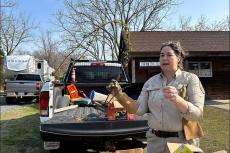While most waters in East Hampton Town were often of a high quality in 2023, what happens on the land affects what happens to surface waters, and more people and more land use mean more nitrogen loading, leading to more harmful algal blooms, the town trustees were told on Monday during an annual report on the waterways.
Christopher Gobler of Stony Brook University’s School of Marine and Atmospheric Sciences told the trustees that efforts to mitigate degraded water quality have paid off in Georgica Pond, yet Wainscott Pond is “a system that’s gotten steadily worse over time,” with toxic cyanobacteria, or blue-green algae, in bloom for much of the year. Fort Pond in Montauk, which is not under trustee jurisdiction, also experienced intense cyanobacteria blooms, reaching more than 200 times above the New York State Department of Environmental Conservation threshold in early September.
Georgica Pond, however, did not experience cyanobacteria blooms last year, but did display low oxygen conditions within its Talmage Creek and Georgica Cove tributaries.
Warmer water holds less oxygen, and water temperatures are rising — particularly in Napeague and Accabonac Harbors last year — which bodes ill for seagrasses and bay scallops. The intense rains that are one manifestation of climate change, seen on the South Fork in July and September last year, led to fecal bacteria levels in Three Mile and Accabonac Harbors that exceeded the D.E.C. and State Health Department standards. Dogs and small mammal-derived bacteria were the most common source.
And last year saw the appearance here of Vibrio vulnificus, a bacterium that enters the body through open wounds or scrapes and can be ingested by eating raw shellfish. Three people in the New York City area died from exposure to the bacterium.
The annual study, in which 14 marine and 10 freshwater sites are sampled, assesses water quality, harmful algal blooms, pathogenic bacteria, and sediments in water bodies including Napeague Harbor, Accabonac Harbor, Hog Creek, Three Mile Harbor, Northwest Creek, Swan Pond, the small pond on Pond Lane, Fresh Pond, Hook Pond, Georgica Pond, Wainscott Pond, and Fort Pond. It also includes continuous monitoring and/or surface mapping of Three Mile Harbor and Georgica Pond because of past instances of harmful algal blooms and/or low dissolved oxygen conditions. Last year, nocturnal hypoxia, or low oxygen levels, occurred in poorly flushed regions of Three Mile Harbor.
Fecal coliform bacteria levels across marine sites were generally low through the spring and summer, according to the report, but “excursions beyond state standards were observed at multiple sites in Accabonac Harbor and Three Mile Harbor,” and levels of Enterococcus in both water bodies on occasion exceeded levels recommended by the Health Department for swimming.
Excessive nitrogen loading leads to hypoxia, which can cause fish kills. Most nitrogen moving from land to sea comes from on-site septic systems, Dr. Gobler told the trustees, with fertilizer usually the second most impactful nutrient. Algal blooms in Three Mile Harbor were consistently promoted by nitrogen loading, he said, with a bloom of the saxitoxin-producing Alexandrium in early April and a Dinophysis bloom in June. Both are harmful to human health.
Rust tide blooms caused by Cochlodinium occurred in August in Hog Creek, Napeague Harbor, and Accabonac Harbor, the latter water body experiencing the densest bloom, though this is not harmful to humans.
Measurements of total nitrogen across marine sites revealed that 13 of 14 locations sampled exceeded the Peconic Estuary Program’s recommended value at least once, and five sites exceeded the threshold on average: two each in Accabonac and Three Mile Harbors, and one in Hog Creek.
The conclusions were mixed for the town’s freshwater bodies, Dr. Gobler said, with a range of good and poor quality. But all freshwater sites sampled exceeded the federal Environmental Protection Agency’s algae standard, and along with Wainscott Pond and Fort Pond, Pond Lane Pond and Swan Pond experienced cyanobacteria blooms exceeding the D.E.C. threshold, warranting closure for varying periods.
Dr. Gobler and a committee of trustees are to meet in the coming weeks to discuss a water monitoring program for 2024.




